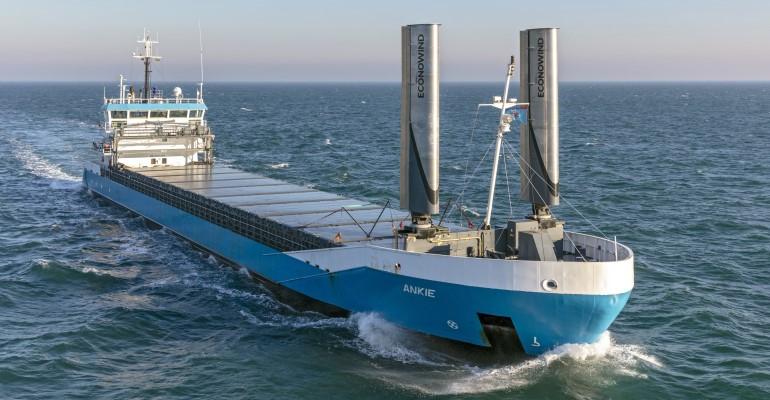In the eighth in a series of interviews ahead of Seatrade Maritime Logistics Middle East, Gavin Allwright, Secretary General, International Windship Association (IWSA), London, UK, spoke to Seatrade Maritime News about developments in the technology.
From an installations standpoint, the IWSA ended 2022 with eight installations made during the year, bringing the total to 24 installations and three wind-ready vessels, for a total of over 1.5m dwt.
“2023 will see an additional 24 installations and an additional six-plus wind-ready vessels, meaning a substantial upswing in the market. From a policy and regulatory basis, we have seen a lot of progress in the recognition of wind-assist and primary wind as a key component in the drive towards decarbonisation and much work is underway in standardising validation, sea-trialling and other technology assessment approaches,” he said.
The IWSA’s associate membership is made up of companies and organisations that share its goals and wish to support the development of the wind propulsion sector. These include five class societies: ABS, BV, ClassNK, DNV and RINA, as well as shipping companies such as Cargill and Blue Planet Shipping. It also has an increasing number of service and component suppliers such as Liebherr, Vaisala, NAPA, Insensys and Thordon Bearings.
“We don’t set out to actively recruit new members. Instead, what attracts them to the association is that this is a growing, dynamic technology market with an active network that is working on policy, regulation, enhancing market drivers and lowering barriers and this is precisely the type of network that they want to engage with and contribute to,” he said.
In the near term, Allwright believes that 100% wind-assist is a panacea that is some way off. He said there were a number of development threads underway in wind propulsion. The two main ones were retrofit or newbuild wind-assist installations that, depending on rig size, design and orientation on the ship, provided a supplement to main engine power of 5%-20% at commercial speeds without any change to the operational profile, when under way as a motor vessel.
“Then we have the primary wind designs for newbuild vessels where large wind propulsion systems are fully integrated into the ship design. These ships will be able to operate mainly using wind to power them on windy routes with weather routing software helping to optimise those routes further. In the near future there are also opportunities to harvest excess wind energy when there is too much wind, which can then be converted to electricity or e-fuels onboard and used when there is no wind.”
When it came to financials, Allwright said each system and each technology provider had their own pricing structures. Taking a macro view, when fuel is priced above $600 a ton, the commercial model becomes quite favourable, at approximately where VLSFO is priced today. However, these systems are already on the market and on average a 10% reduction in cost will be seen every time installations are doubled to achieve economies of scale.
“We need to remember that wind propulsion technologies are harvesting a globally available energy source that is abundant and delivered directly to the point of use free of charge over the lifetime of the vessel. This zero-emissions, zero-cost energy source means that it is the only alternative propulsion option that actually has a return on investment,” he said.
Allwright estimates that the cost to roll out this technology across the global fleet of 60,000 ships this decade would likely be $200bn-$300bn by 2030, but that that would pay for itself by 2035, even at a modest 20% power contribution, and at that level would still return total fuel savings in the region of over $1trn by 2050.
“Regulators can assist this transition by incorporating wind propulsion into the heart of the decarbonisation drive, delivering on a substantial carbon levy level, adopting an ‘energy-centric’ approach, assessing all fuels on a level playing field, well-to-wake alongside direct wind power, and even mandating all new vessels be designated wind-ready or wind installed,” he said.
Allwright believes that if the ‘hybrid’ approach to decarbonisation—which could bring reductions in fuel and emissions of 20% or more—involves installing wind propulsion, vessel optimisation with energy efficiency measures along with operational optimisation with speed reduction, virtual arrivals and then filling the remaining gap with alternative-, low- and zero-emissions fuels, then shipping has the opportunity to move into pole position in the decarbonisation-of-transport race.
“The shipping industry is unique in the transportation sector in having access to this free, direct energy source—we used it for millennia and now we have updated, upgraded and rethought the systems we use to harness that zero-emissions energy—an elegant 21st Century solution for a huge 21st Century challenge!”
Gavin Allwright, Secretary General, International Windship Association (IWSA), London, UK, is speaking at Seatrade Maritime Logistics Middle East, on May 16-18, 2023, in Dubai, UAE.
Copyright © 2024. All rights reserved. Seatrade, a trading name of Informa Markets (UK) Limited.
Add Seatrade Maritime News to your Google News feed.  |


